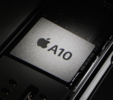Apple A10 Fusion vs Apple A16 Bionic
Apple A10 Fusion
► remove from comparison
The Apple A10 Fusion is a system on a chip (SoC) from Apple that is built into the iPhone 7 and iPhone 7 Plus. It integrates four 64 Bit cores that are divided in two clusters. Two high performance cores are clocked at up to 2.34 GHz and should be around 40% faster than the Apple A9 (according to Apple) and two low power cores (up to 1.1 GHz?). Up to now its unclear if all four cores can be used at once (that need only 1/5 th of the energy in some use cases). At the release of the iPhone 7 it looks like that IOS is only using two cores at a time and automatically switches between the two clusters. Therefore, apps are seeing only a dual core. The principle is similar to the first generation of ARMs big.LITTLE concept.
The integrated graphics card of the SoC will most likely stem from PowerVR (again) and perform 50% faster at 2/3 of the power consumption (according to Apple).
All in all the chip includes 3.3 billion transistors, which is more than a current AMD Bristol Ridge (3.1) and Skylake Quad-Core (1.75) X86 SoCs.
Sources: Apple Keynote, Ars Technica
Apple A16 Bionic
► remove from comparison
The Apple A16 Bionic is a System on a Chip (SoC) from Apple that is found in the iPhone 14 Pro (2022) models. It offers 6 cores divided in two performance cores (codename Everest, up to 3.46 GHz) and four power-efficiency cores (codename Sawtooth, up to 2.02). According to Apple, the most improvements were made to the efficiency cores and the improved memory bandwidth (+50% thanks to LPDDR5). According to the die analysis from angstronomics, the e-core cluster still has the same 4 MB L2 cache, but the p-cores now offer 16 MB L2 cache. The SLC (System Level Cache) however seems to be reduced to 24 MB.
The Neural Engine still offers 16 cores and offers an increased performance of 17 TOPS (vs. 15.8 of the A15) for AI tasks. The integrated graphics engine still offers 5 cores and benefits mostly from the higher memory bandwidth. The new display engine supports adaptive refresh rates down to 1 Hz, the new always-on display, and improved anti-aliasing (for the dynamic island animations).
The CPU performance only shows small improvements to the last generation (Apple A15 Bionic). Still, the A16 is by far the fastest mobile CPU for smartphones and leaves e.g. the Snapdragon 8+ Gen 1 easily behind (in Geekbench 5.4 single- and multi-thread tests).
The chip is manufactured on the modern 4nm process at TSMC and integrates nearly 16 billion transistors (compared to the 15.8 billion of the A15 and 11.8 of the A14). Apple emphasized on efficiency and e.g. mentioned 20% power savings for the big performance cores and class-leading efficiency of the e-cores.
| Model | Apple A10 Fusion | Apple A16 Bionic |
| Codename | APL1021 Hurricane / Zephyr | Crete |
| Series | Apple Apple A-Series | Apple Apple A-Series |
| Clock | 2340 MHz | 2020 - 3460 MHz |
| Cores / Threads | 4 / 2 | 6 / 6 |
| Transistors | 3300 Million | 16000 Million |
| Technology | 16 nm | 4 nm |
| Features | ARMv8 Instruction Set | ARMv8 Instruction Set, Machine Learning Controller, 16-Core Neural Engine, Secure Enclave, Advanced Image Signal Processor |
| iGPU | Apple A10 Fusion GPU / PowerVR (900 MHz) | Apple A16 GPU 5-Core |
| Architecture | ARM | ARM |
| Announced | ||
| L2 Cache | 20 MB | |
| L3 Cache | 24 MB |
Benchmarks
Average Benchmarks Apple A10 Fusion → 100% n=9
Average Benchmarks Apple A16 Bionic → 291% n=9
* Smaller numbers mean a higher performance
1 This benchmark is not used for the average calculation











